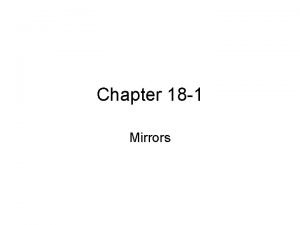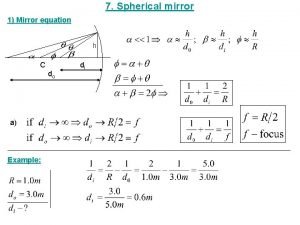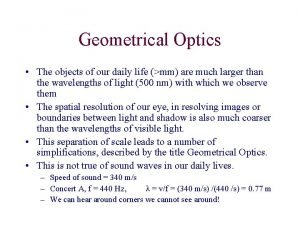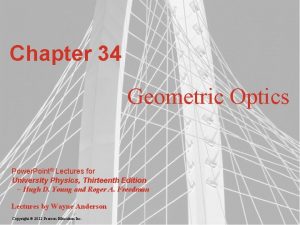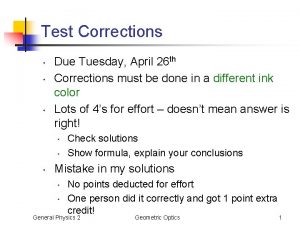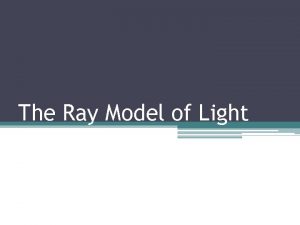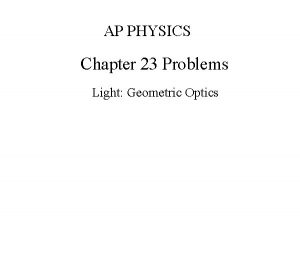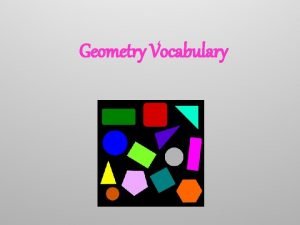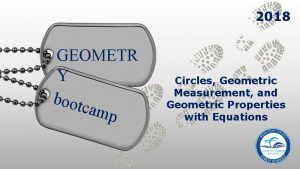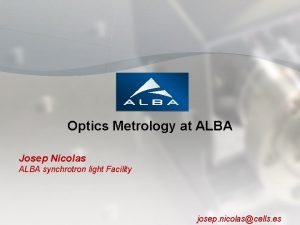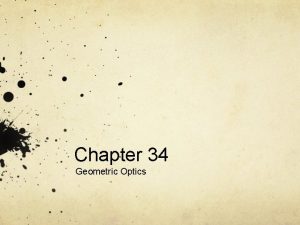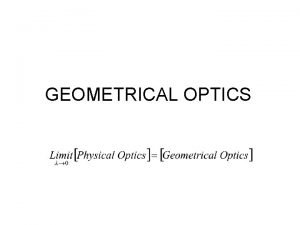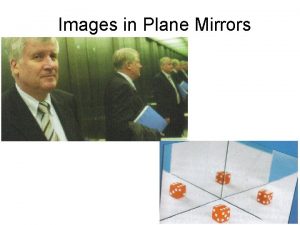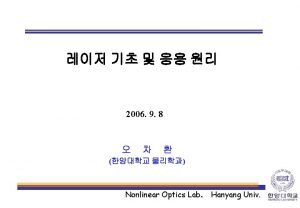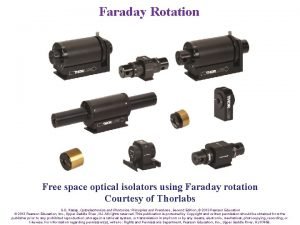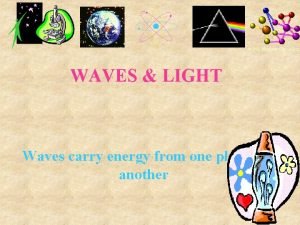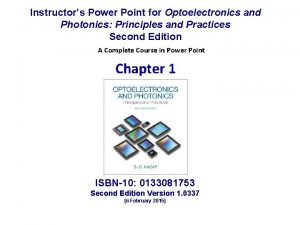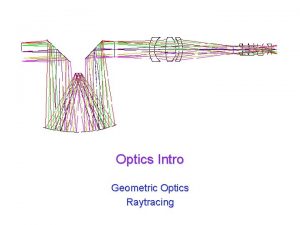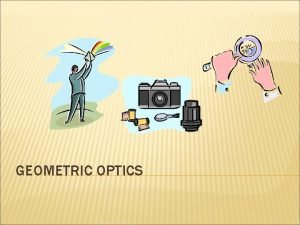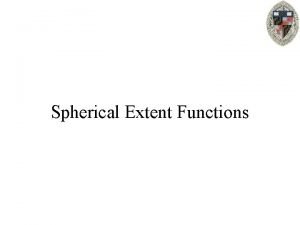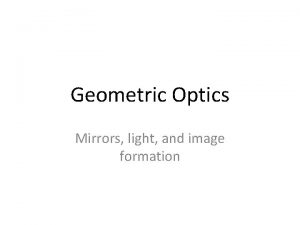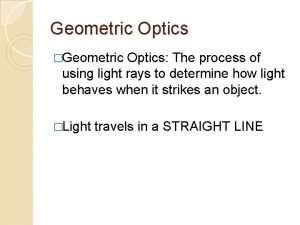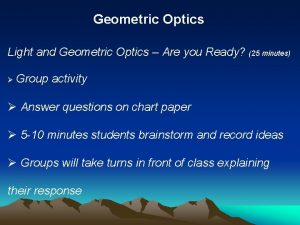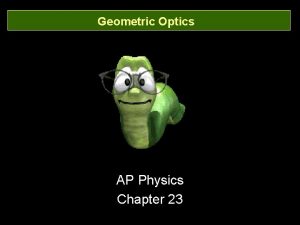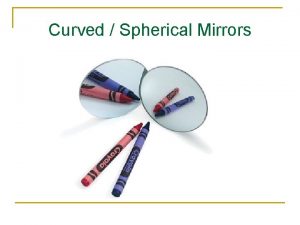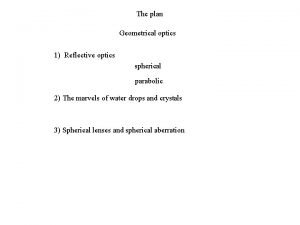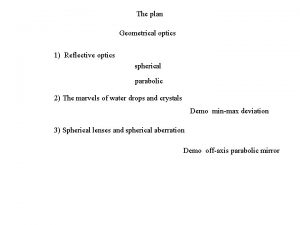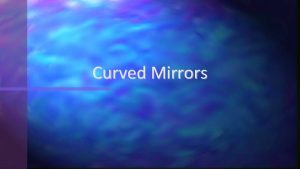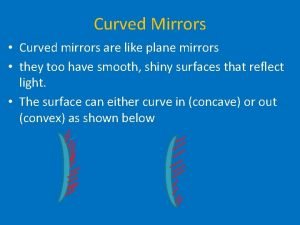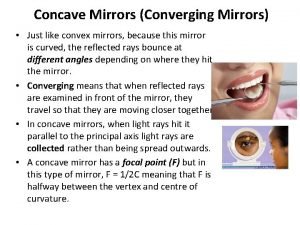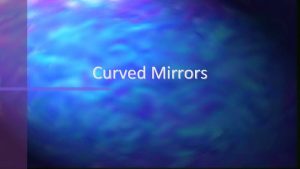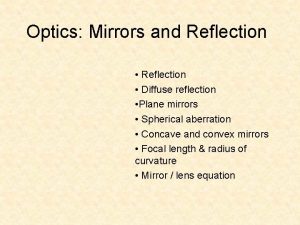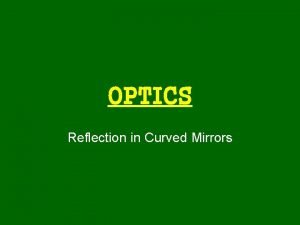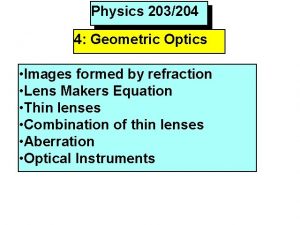GEOMETRIC OPTICS SPHERICAL MIRRORS Mirrors that are formed




































- Slides: 36

GEOMETRIC OPTICS

SPHERICAL MIRRORS Mirrors that are formed from a section of a sphere. Convex: The reflection takes place on the outer surface of the spherical shape Concave: The flection surface is on the inner surface of the sphere.

OBJECTS FROM FAR AWAY If objects are infinitely far away from a mirror (The sun, the stars, etc), the rays would be precisely parallel. The law of reflection holds for each of the parallel rays, but they will not all reflect to be brought to a single point. This causes an unfocused image.

SPHERICAL ABBERATION

ASSUMPTION FOR THIS CLASS… We will assume that the mirror is small in comparison to its radius of curvature. This way, only a small angle is made upon reflection. This will cause the light to reflect at nearly in the same point, called a focus.

PARTS OF A MIRROR RAY DIAGRAM Principle axis: The straight line perpendicular to the curved surface at its center. Focal point: The point where rays parallel to the principle axis come to a focus. Image Focal location of an object infinitely far away. length: the distance from the focal point to the mirror. Radius of curvature: the center of the sphere the mirror is made from


3 STEPS TO A RAY DIAGRAM FOR SPHERICAL MIRRORS Ray 1: drawn parallel to the principle axis, and then passes through the focal point after reflection.

3 STEPS TO A RAY DIAGRAM FOR SPHERICAL MIRRORS Ray 2: drawn through F; therefore must reflect parallel to the principle axis.

3 STEPS TO A RAY DIAGRAM FOR SPHERICAL MIRRORS Ray 3: Perpendicular to the mirror, passes through the radius of curvature.

RAY DIAGRAM

SUMMARY Ray 1 goes from object parallel to the axis and reflects through the focal point. Ray 2 goes from object through focal point and reflects parallel to the axis. Ray 3 goes from object, perpendicular to the mirror, reflects back on itself through the center of curvature.

TYPES OF IMAGES Virtual Image: If a film or paper were placed in the location of the image, rays would not actually pass through this location. Real Image: light does pass through the location of the image. If a film were placed at the image position, light would be put onto the film.

OTHER WAYS TO FIND IMAGES We could always use ray diagrams, but accuracy is difficult. Mirror equation S represents distance of image and object. f represents the focal length.

MAGNIFICATION Magnification is the image height divided by the object height. Sign conventions Positive image height means upright, negative is inverted relative to the object. Positive distance is in front of the mirror, and negative is behind the mirror.

PRACTICE #1 A 1. 50 cm high diamond ring is placed 20 cm from a concave mirror whose radius of curvature is 30 cm. Determine the position and size of the image.

PRACTICE #2 A 1. 00 cm high object is placed 10 cm from a concave mirror whose radius of curvature is 30 cm. A) Draw a ray diagram to locate (approximately) the position of the image. B) determine the position of the image and the magnification analytically.

PRACTICE #3 A 4 cm high object is placed 3 cm in front of a convex mirror with a radius of curvature of 8 cm. Create a ray diagram to find the approximate location of the image. Analytically determine the position and magnification of the image.

PRACTICE #4 A convex rearview car mirror has a radius of curvature of 40 cm. Determine the location of the image and its magnification for an object 10. 0 m from the mirror.

THIN LENSES A lens is made up of two faces that are usually portions of a sphere. The two faces can be either concave or convex. We only use thin lenses in this class which means that the diameter of the lens is small compared to the radii of curvature of the two lens surfaces.

PARTS OF A LENS Focal point: The point in which an object at an infinite distance from the lens is focused. Focal length: the distance of the focal point to the center of the lens. Note that a lens has two faces and therefore two focal points.

TYPES OF LENSES Converging lens: a lens that is thicker in the center than at the edges makes parallel rays converge to a point. Diverging lens: a lens that is thinner in the center than at the edges makes parallel rays diverge. The focal point is defined as the point from which refracted rays seem to have emerged from as a single point.


3 STEPS TO A RAY DIAGRAM FOR THIN LENSES Ray 1: parallel to the axis and then refracted through the focal point on the opposite side.

3 STEPS TO A RAY DIAGRAM FOR THIN LENSES Ray 2: Passes through the F’ on the same side of the lens as the object and then goes parallel to the axis beyond the lens.

3 STEPS TO A RAY DIAGRAM FOR THIN LENSES Ray 3: directed towards the very center of the lens, and emerges the same angle as it entered.

SUMMARY Ray 1: leaves the top of the object going parallel to the axis and then refracts through the focal point. Ray 2: passes through F’ and leaves the lens parallel to the axis. Ray 3: goes straight from the object through the center of the lens and back out the same angle.

REAL VS. VIRTUAL IMAGES Notice, that in the case of a lens, the light of the image, on the opposite side of the lens, is able to be detected by film. Opposite than a mirror, a real image is on the opposite side of the lens. A virtual image is on the same side of the lens.

DIVERGING LENS

ANALYTICALLY Luckily it is the same as the mirror equations

SIGN CONVENTIONS The focal length is positive for converging lenses and negative for diverging lenses. The object distance is positive if it is on the side of the lens from which the light is coming (this is usually the case, although when lenses are used in combination, it might not be so); otherwise, it is negative

MORE SIGN CONVENTIONS The image distance is positive if it is on the opposite side of the lens from where the light is coming; if it is on the same side, then it is negative. If the image distance is positive, then the image is real. The height of the image is positive it if it is upright.

PRACTICE #1 What is the position and the size of the image of a large 7. 6 cm high flower placed 1. 0 m from a +50 mm focal length camera lens?

PRACTICE #2 An object is placed 10 cm from a 15 cm focal length converging lens. Determine the image position and size analytically and using a ray diagram.

PRACTICE #3 Where must a small insect be placed if a 25 cm focal length diverging lens is to form a virtual image 20 cm in front of the lens?

PRACTICE #4 (TWO-LENS SYSTEM) Two converging lenses, with focal lengths of 20 cm and 25 cm are placed 80 cm apart. An object is placed 60 cm in front of the first lens. Determine the position and magnification of the final image formed by the combination of the two lenses.
 Venn diagram of geometric optics and physical optics
Venn diagram of geometric optics and physical optics Insidan region jh
Insidan region jh Difference between ray optics and wave optics
Difference between ray optics and wave optics Plane concave and convex mirrors
Plane concave and convex mirrors Formula concave mirror
Formula concave mirror Take a large shining spoon
Take a large shining spoon Critical angle
Critical angle Geometric optics ppt
Geometric optics ppt Physics 2
Physics 2 Name the two parts that make up most mirrors
Name the two parts that make up most mirrors Optics
Optics Walmart thất bại ở nhật
Walmart thất bại ở nhật Thơ thất ngôn tứ tuyệt đường luật
Thơ thất ngôn tứ tuyệt đường luật Gây tê cơ vuông thắt lưng
Gây tê cơ vuông thắt lưng Ngoại tâm thu thất chùm đôi
Ngoại tâm thu thất chùm đôi Tìm độ lớn thật của tam giác abc
Tìm độ lớn thật của tam giác abc Sau thất bại ở hồ điển triệt
Sau thất bại ở hồ điển triệt Premature atrial contraction
Premature atrial contraction Hãy nói thật ít để làm được nhiều
Hãy nói thật ít để làm được nhiều Thể thơ truyền thống
Thể thơ truyền thống Tôn thất thuyết là ai
Tôn thất thuyết là ai A polygon is a closed figure formed
A polygon is a closed figure formed Circles geometric measurement and geometric properties
Circles geometric measurement and geometric properties Optics
Optics Divergin
Divergin The computational complexity of linear optics
The computational complexity of linear optics Laws of optics
Laws of optics Salt characteristics optics
Salt characteristics optics Nonlinear optics
Nonlinear optics Grade 10 optics review
Grade 10 optics review Nonlinear optics
Nonlinear optics Disadvantage of optical fiber
Disadvantage of optical fiber What medical procedure uses fiber optics bill nye
What medical procedure uses fiber optics bill nye Fiber optics richard sanders
Fiber optics richard sanders Cauchy formula optics
Cauchy formula optics Optics
Optics What is with the rule and against the rule astigmatism
What is with the rule and against the rule astigmatism



